Reykjanesbær
Reykjanesbær is a municipality on the Southern Peninsula (Suðurnes) in Iceland. It is made up of the towns Keflavík, Njarðvík and the village of Hafnir. The municipality was created in 1994 when the inhabitants of the three towns voted to merge them into one. Reykjanesbær is the fifth largest municipality in Iceland, with 18.920 citizens (2019).[1][2] [3]
| Reykjanesbær | |
|---|---|
.jpg) Skyline of Reykjanesbær | |
 Coat of arms of Reykjanesbær | |
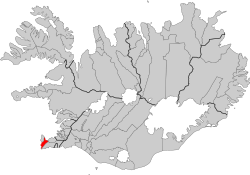 Location of Reykjanesbær | |
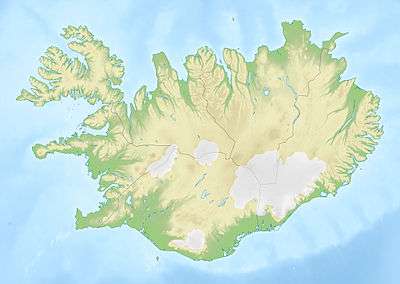 Reykjanesbær | |
| Region | Southern Peninsula |
| Constituency | Southwest Constituency |
| Mayor | Kjartan Már Kjartansson |
| Area | 145 km2 (56 sq mi) |
| Population | 18,920 (2019)[1] |
| Density | 130.49/km2 (338.0/sq mi) |
| Municipal number | 2000 |
| Postal code(s) | 230, 232, 233, 235, 260 |
| Website | reykjanesbaer |
Overview
Of the three towns which make up the municipality, Keflavík is the largest, while Hafnir is the smallest and some 10 kilometers distant. Keflavík and Njarðvík were originally distinct towns but gradually grew together over the course of the latter half of the 20th century, until the only thing separating them was a single street. The northern side of the street belonged to Keflavík and the southern side to Njarðvík. Since May 2009 the township of Njarðvík has been the location of the Viking World museum ( Víkingaheimar).[4]
In 2006, when the United States Navy closed Naval Air Station Keflavik, the site was taken over by the development agency Kadeco, and renamed Ásbrú. A university, Keilir, was founded and now Ásbrú houses the campuses of various educational institutions and also businesses, both newly founded and relocated to the site of the air base.[5][6]
Demographics
| Residents by citizenship (1 January 2018)[7] | |||||||||||||||||||||||||||||||||||||||||||
| Nationality | Population | ||||||||||||||||||||||||||||||||||||||||||
|---|---|---|---|---|---|---|---|---|---|---|---|---|---|---|---|---|---|---|---|---|---|---|---|---|---|---|---|---|---|---|---|---|---|---|---|---|---|---|---|---|---|---|---|
| 14,163 (79.55%) | |||||||||||||||||||||||||||||||||||||||||||
| 2,526 (14.19%) | |||||||||||||||||||||||||||||||||||||||||||
| 208 (1.17%) | |||||||||||||||||||||||||||||||||||||||||||
| |||||||||||||||||||||||||||||||||||||||||||
Reykjanesbær is the most populous municipality in the Suðurnes region, the fourth most populous in Iceland, and the most populous outside of the Greater Reykjavík area. The municipality had a population of 18,920 on 1 January 2019; that is about 5.3% of the country's population. The Suðurnes region, which includes Reykjanesbær and five neighbouring municipalities, was home to 27,113 people; that is about 7.6% of the country's population.[1]
On 1 January 2018, of the town's population of 17,805, immigrants of the first and second generation numbered 4,352 (24.4%).[8][9] The most common foreign citizens were Poles, Lithuanians, and Latvians.[7]
Points of interest
Twin towns – sister cities
Reykjanesbær is twinned with:[10]


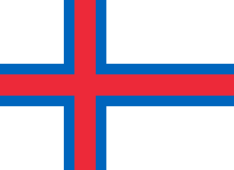


Gallery
- Reykjanesbær
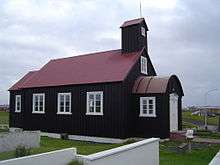 Church of Hafnir (Kirkjuvogskirkja)
Church of Hafnir (Kirkjuvogskirkja)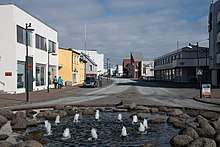 Keflavik town center
Keflavik town center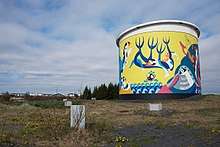 Old Water Reserve Tank
Old Water Reserve Tank.jpg) Street in Keflavík
Street in Keflavík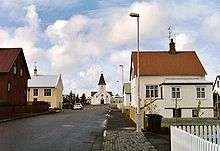 Church of Keflavik
Church of Keflavik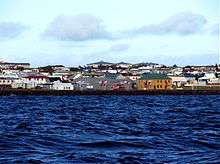 Keflavík harbour
Keflavík harbour.jpg) Aerial view of Keflavík International Airport
Aerial view of Keflavík International Airport
References
- "Population by municipalities, sex and age 1 January 1998-2019 - Current municipalities". www.hagstofa.is. Statistics Iceland. 1 January 2019. Retrieved 15 May 2019.
- "Reykjanesbær municipality". reykjanesbaer.is. Retrieved December 1, 2019.
- "Suðurnes". citypopulation.de/. Retrieved December 1, 2019.
- "Víkingaheimar". Lonely Planet. Retrieved December 1, 2019.
- "Keflavik Air Base, Iceland". navytimes.com. Retrieved December 1, 2019.
- "Keilir Educational Institution". keilir.net. Retrieved December 1, 2019.
- "Population by sex, municipality and citizenship 1 January 1998-2018". www.hagstofa.is. Statistics Iceland. 1 January 2018. Retrieved 15 May 2019.
- "Population by municipalities, sex and age 1 January 1998-2019 - Current municipalities". www.hagstofa.is. Statistics Iceland. 1 January 2018. Retrieved 15 May 2019.
- "Immigrants by sex and municipality 1 January 1996-2018". www.hagstofa.is. Statistics Iceland. 1 January 2018. Retrieved 15 May 2019.
- "Vinabæir". reykjanesbaer.is (in Icelandic). Reykjanesbær. Retrieved 2020-02-12.
| Wikimedia Commons has media related to Reykjanesbær. |